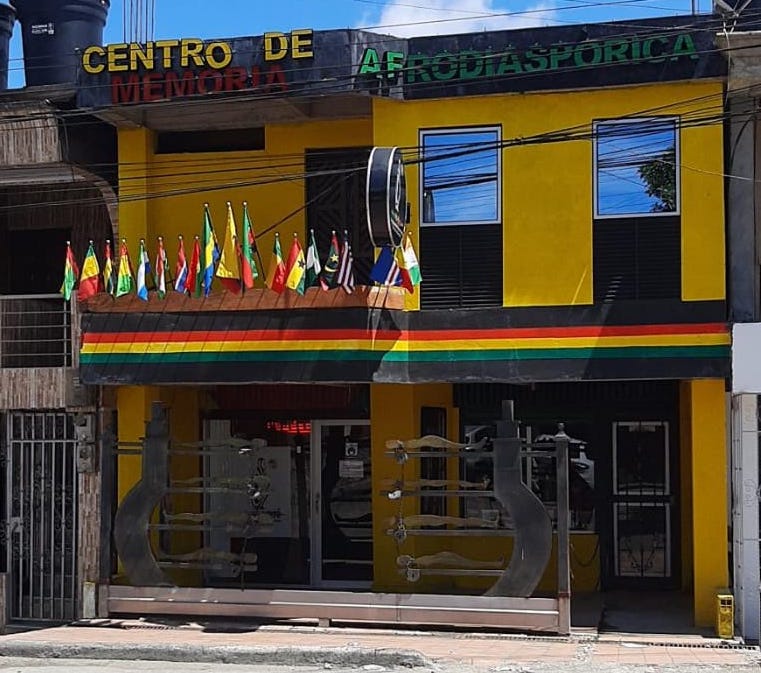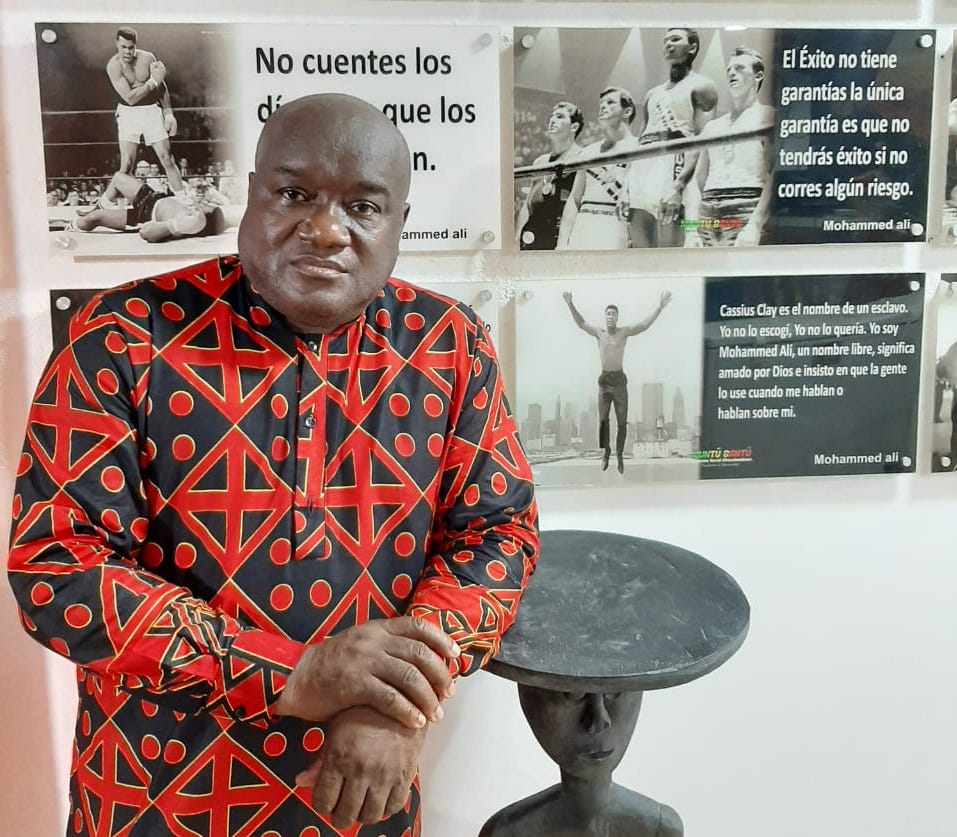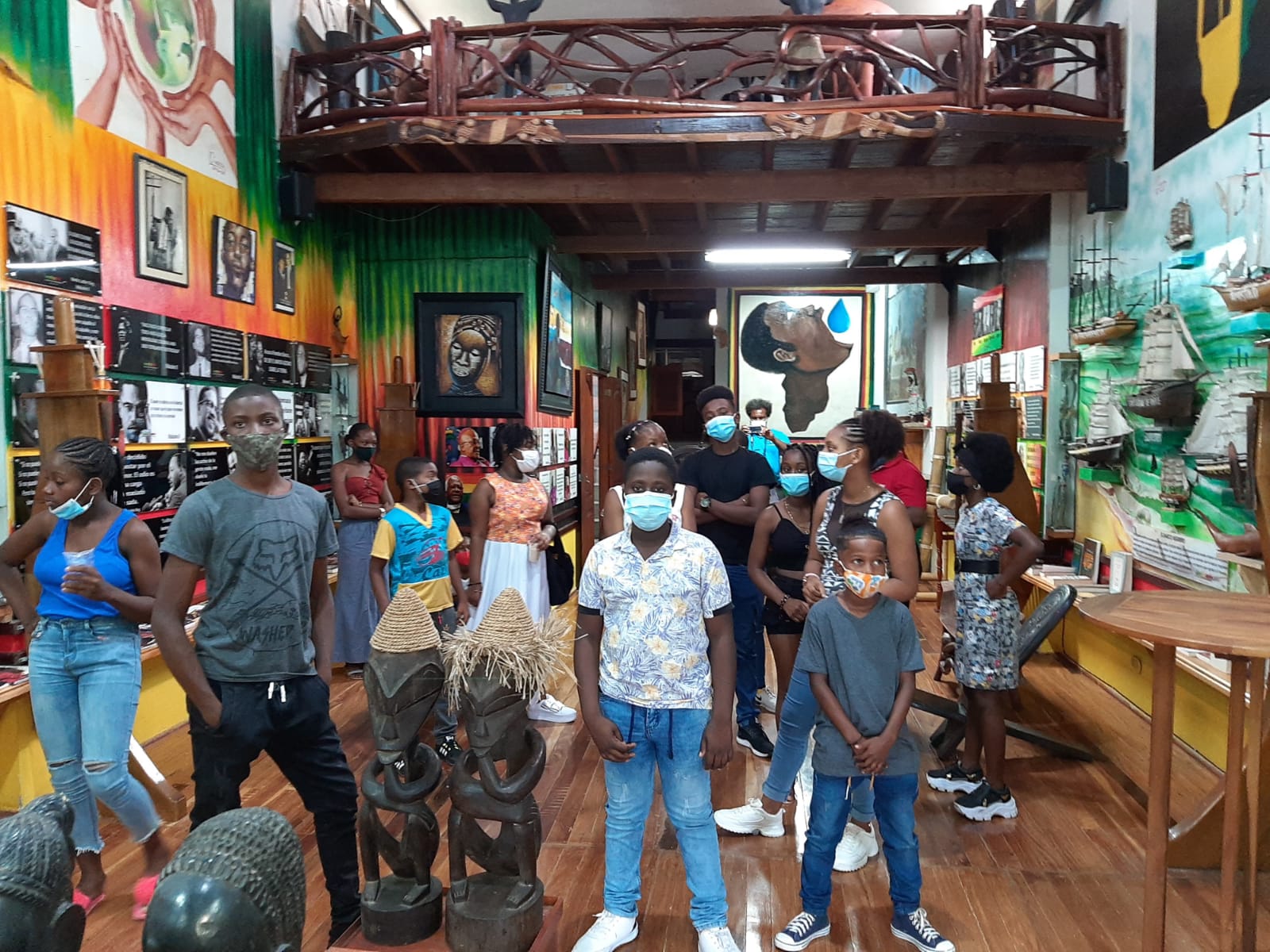

Sergio Antonio Mosquera gives a private tour of Muntú Bantú in Quibdó, Colombia. (Courtesy of Muntú Bantú)
On the outskirts of the city of Quibdó, in the middle of the immense jungles on Colombia’s Pacific coast, a replica of a slave ship harbors the history of Black people on the continent.
At street level the building is unremarkable. Besides a collection of African flags hanging from a balcony, the words “Centro de Memoria Afrodiaspórica“ emblazoned on the façade, and a sculpture of eight bodies, chained and lying on their backs —as Africans were when they were forcibly shipped across the Atlantic centuries ago— the yellow construction resembles the irregular and basic buildings that abound in the city and the rest of the country. Yet, after scratching the surface, it is unique.
Named Muntú Bantú, this apparently inconspicuous structure is an independently run center dedicated to the memory of the African diaspora, the only one of its kind in Colombia. After 20 years of very hard work, however, support for and interest in the project remains scarce.


Courtesy of Muntú Bantú
The center is the brainchild of Sergio Antonio Mosquera, a historian from the region who decades ago, after traveling to various countries in America and Africa, became determined to preserve and share the bonds —cultural, spiritual, and of memory— that link all the descendants of slaves o the continent.
“I realized that the history that was being told everywhere was incomplete because it did not include Africa, despite the fact it is the cradle of humanity and that world capitalism was built on the massive enslavement of its people,” Mosquera tells Latino Rebels. “For me, confronting this silencing was necessary. so I came up with the idea of a center of memory —rejecting the tag of ‘museum,’ which has come to represent the hegemonic narrative— because we must know what happened, why it happened, what repercussions it’s had and make sure it never happens again.”
Mosquera’s objectives for the center are broadcast through its very name. “Bantú” refers to the region of Africa where most of the slaves who were brought to Colombia were taken from. “Muntú,” on the other hand, means spirituality in traditional Bantu languages. Mosquera notes that this is what has been passed down through generations and which has come to represent, for him, the connection between Black people in America.
Together, “Muntú Bantú,” he explains proudly, stands for all Afro-Americans’ bodies and souls. After being continuously violated and negated for centuries, Mosquera is determined to vindicate and protect them.


Sergio Antonio Mosquera, an Afro-Colombian historian and the founder of Muntú Bantú (Courtesy of Muntú Bantú)
Yet, despite its clear and worthy ambitions, the project hasn’t been easy to realize. Talking about Black history in depth is a non-starter in Colombia. The teaching of such history has been excluded from the school curriculum for the last 35 years, and up until 1991, the Colombian constitution did not acknowledge the presence of non-white people, even though at least 10 percent of the population is Black, the second-highest percentage in South America. Rather, in the few occasions when the marginalized Afro-Colombians are considered at all, securing their votes is the main priority.
As a result, since Mosquera started the project, external funding has been hard to come by. The site itself had to be bought, and the building erected from scratch, with precarious financing in the early 2000s. From the moment it finally opened in 2009, they have depended on ticket and book sales, and the odd donation, to expand slowly. There have been a few occasions when they have received more generous offers, although they prefer not to say from whom because the gifts came with conditions that Mosquera considered blatant whitewashing.
This fierce independence is reflected in Muntú Bantú’s slightly kitsch aesthetic and lack of professional curatorial work, which they openly acknowledge but compensate for with plenty of dedication. It all ties in with their mission of preserving a history untold in books and schools, susceptible to being lost and not entirely understood.
A clear example of this are the religious traditions that have developed in Afro-American communities all over the continent, which people continue to practice even though they might not be aware of the deeper meanings behind certain customs. “Here in Chocó we have gualí or chigualo, which is the funeral rite for when a child dies, “Mosquera explains. “It is a party, people dance, and everyone is happy. Originally the joy was because in the consciousness of Black women especially, a child dying was a good thing cause it affected the master’s business. And also because the child’s soul would return to Paradise —Africa— since he could not have sinned.
“Today, people still follow the custom, but they don’t know why.”
With a center for memory established, this shared history can be kept safe from the amnesia produced by modern globalizing trends, in an environment where pedagogy and conscience-building are central.


Teenagers and children from Quibdó visit the “deck” of Muntú Bantú. (Courtesy of Muntú Bantú)
Indeed, the place was always meant to serve Colombia’s Black population, rather than to profit from the visitors who walk through its doors. This is why the center was built in Quibdó and not, for example, in better-known Cartagena, one of the major ports of entry for Africans during the slave trade but which currently has an economy based entirely on tourism.
On the other hand, Chocó, the state of which Quibdó is the capital, with a population that is more than 90 percent Black, has been historically ignored by the state, which permits African traditions such as the gualí to survive only in small communities deep in the isolated jungles of the region. Nevertheless, that same marginalization has had terrible consequences: Chocó is the poorest region in the country, it is deeply wounded after decades of armed conflict, and is currently being bled by disputes between gangs and drug traffickers who covet its ports on both the Caribbean and the Pacific and the little to no state presence. These recurring violent dynamics, especially the displacement they produce, endanger the communities’ connection with their roots, which is why Muntú Bantú is there to preserve those ties and restore pride in them.
Everything in the slave ship-shaped building clearly reflects that aim. From highlighting the grit of the Africans who crossed the Atlantic in the very first room, to explaining the special relationship with nature inherited from their ancestors, up to a small cinema built to screen Black films, Muntú Bantú is a celebration of the mettle and resistance of the entire Black community, as well as an archive of their historical grievances.
Unfortunately, the little attention and support it has garnered since its opening only serves to show why its work is so necessary.
—
Muntú Bantú is open for donations on their website or their different social media accounts.
***
Nicholas Dale Leal is a Colombian-British journalist based in Madrid. Twitter: @ndaleleal


